I need help with my C programing Problem Part 1A Develop the
I need help with my C programing.
Problem:
Part 1A: Develop the Maze
You will generate a random maze of characters in a two dimensional array. This will be the same maze that you output to the screen. Using good modular programming techniques, generate the maze and display it on the screen.
The rand() function in stdlib.h will be very useful, as it will return a new random int every time it is called that is from 0 to a very large number. HINT: Taking rand\'s output % 100 may be useful.
To allow for differing levels of difficulty, your code will be given a difficulty value of 0-100 on the command line. This difficulty is the probability in percent that a given space of the maze will be an obstacle. Hence, difficulty zero indicates a blank maze while 50 indicates that roughly half of the characters will be blank.
Part 1B: Character Movement
The second part of the state is the avatar\'s position. In the sample code provided, we have included a function that lets you write to a character to a specific x,y position on the screen. Be sure to use this function (draw_character). DO NOT MODIFY THIS FUNCTION. In a loop, you will make the character begin at the top center of the screen and move downward every so often. Note that if you do this without a delay, the program will complete so fast that you can barely see the avatar move.
To add delay, remember that if the -t option is given to ds4rd.exe, the first argument is the time in milliseconds since the executable starts. Use this data to wait some number of milliseconds (a delay for you to determine), and then implement the avatar moving down the screen with the delay. You may wish to keep track of a moving average of the gryroscope as well here so that you can use them to control the avatar next week.home / study / engineering / computer science / questions and answers / i need help with my c programing. problem: part ...
Source Code to Follow (Do not edit):
Thank you!
Solution
// Headers
#include <stdio.h>
#include <stdlib.h>
#include <math.h>
#include <ncurses/ncurses.h>
#include <unistd.h>
#include <string.h>
// Mathematical constants
#define PI 3.14159
/* Screen geometry
Use NUMROWS and NUMCOLS for the screen height and width (set by system)
*/
#define NUMROWS 80
#define NUMCOLS 100
/* Character definitions */
#define AVATAR \'A\'
#define WALL \'*\'
#define EMPTY_SPACE \' \'
#define WAIT_TIME 300
#define TRUE 1
#define FALSE 0
#define MAXPOINTS 10000
#define BUFF_LENGTH 10
#define UP 0
#define DOWN 1
#define LEFT 2
#define RIGHT 3
#define NONE 4
#define NUM_SAMPLES 10
/* 2D character array which the maze is mapped into
You should fill this with characters, not numbers. */
char MAZE[NUMROWS][NUMCOLS];
/* PRE: The level of difficulty will be entered on the command line.
You will have to use the argument to the command line to determine how
difficult the maze is (how many maze characters are on the screen).
POST: Generates a random maze structure into MAZE[][]
You will want to use the rand() function and maybe use the output %100. */
void generate_maze(int difficulty);
/* PRE: MAZE[][] has been initialized by generate_maze()
POST: Draws the maze to the screen. You must use the draw_character
function to print to the screen. You cannot use printf in curses. */
void draw_maze(void);
/* PRE: 0 < x < NUMCOLS, 0 < y < NUMROWS, characters are defined above
POST: Draws character use to the screen and position y,x as in a graph
where x is the horizontal axis and y is the vertical axis.
When using the i and j from the maze, you will want to remember that
i (outer loop) is the rows and corresponds to y, while j is the columns
and corresponds to x. */
void draw_character(int x, int y, char use);
/* PRE: -1.0 < x_mag < 1.0
POST: Returns tilt magnitude scaled to -1.0 -> 1.0
You may want to reuse the roll function written in previous labs. */
double calc_roll(double x_mag);
// compute the average of the first num_items of buffer
double avg(double buffer[], int num_items);
//update the max and min of the first num_items of array
void maxmin(double array[], int num_items, double* max, double* min);
//shift length-1 elements of the buffer to the left and put the
//new_item on the right.
void updatebuffer(double buffer[], int length, double new_item);
int close_to(double tolerance, double point, double value);
int scrub_lines(int posx, int posy);
// Main - Run with \'./explore.exe -t -a -b\' piped into STDIN
void main(int argc, char* argv[])
{
int difficulty, ax, ay, moving;
if(argc > 1) {
difficulty = atoi(argv[1]);
} else {
printf(\"Please provide an argument for difficulty\ \");
exit(-1);
}
// setup screen
initscr();
refresh();
// Generate and draw the maze, with initial avatar
generate_maze(difficulty);
draw_maze();
ay = 0;
ax = NUMCOLS/2;
// Read accelerometer data to get ready for using moving averages.
int b[6];
//avatar x, avatar y : ax, ay
int t;
double x, y, z, avg_x, avg_y, avg_z, xmin, xmax, ymin, ymax, zmin, zmax;
double arr_x[MAXPOINTS], arr_y[MAXPOINTS], arr_z[MAXPOINTS];
// Event loop
char next_char = MAZE[ay][ax];
int alt_y = ay;
int alt_x = ax;
int last_t, first;
char txt[25];
first = TRUE;
do
{
// Read data, update average
scanf(\"%d, %lf, %lf, %lf, %d, %d, %d, %d, %d, %d\", &t, &x, &y, &z, &b[0], &b[1], &b[2], &b[3], &b[4], &b[5] );
if(first == TRUE) {
last_t = t;
first = FALSE;
}
if(t - last_t >= WAIT_TIME) {
moving = TRUE;
last_t = t;
} else {
moving = FALSE;
}
//do the average-y stuffs
updatebuffer(arr_x, BUFF_LENGTH, x);
updatebuffer(arr_y, BUFF_LENGTH, y);
updatebuffer(arr_z, BUFF_LENGTH, z);
avg_x = avg(arr_x, BUFF_LENGTH);
avg_y = avg(arr_y, BUFF_LENGTH);
avg_z = avg(arr_z, BUFF_LENGTH);
maxmin(arr_x, BUFF_LENGTH, &xmax, &xmin);
maxmin(arr_y, BUFF_LENGTH, &ymax, &ymin);
maxmin(arr_z, BUFF_LENGTH, &zmax, &zmin);
int move_dir = NONE;
int valid = TRUE;
//tol point val
//if(ax+1 < NUMCOLS && ax-1 > 0)
if(close_to(0.5, 1, x) == TRUE && ax > 0) {
move_dir = LEFT;
} else if(close_to(0.5, -1, x) == TRUE && ax+1 < NUMCOLS) {
move_dir = RIGHT;
}
if(move_dir == LEFT) {
if(MAZE[ay][ax-1] == \'*\') {
move_dir = NONE;
}
} else if(move_dir == RIGHT) {
if(MAZE[ay][ax+1] == \'*\') {
move_dir = NONE;
}
}
// Is it time to move? if so, then move avatar
if(moving == TRUE) {
draw_character(alt_x, alt_y, next_char);
draw_character(ax, ay, AVATAR);
//otherwise it\'s off-screen
if(ay+1 < NUMROWS) {
alt_y = ay;
if(MAZE[ay+1][ax] != \'*\') {
ay++;
}
alt_x = ax;
if(move_dir == LEFT) {
ax--;
} else if(move_dir == RIGHT) {
ax++;
} else {
ax = ax;
}
//no diagonals
if(y != alt_y && x != alt_x) {
y = alt_y;
}
next_char = MAZE[alt_y][alt_x];
}
if(ay == NUMROWS-1) {
strcpy(txt, \"YOU WIN!\ \");
break;
} else if(MAZE[alt_y][alt_x-1] == WALL && MAZE[alt_y][alt_x+1] == WALL && MAZE[alt_y+1][alt_x] == WALL) {
strcpy(txt, \"YOU LOSE!\ \");
break;
} /*else if(scrub_lines(alt_x, alt_y) == FALSE) {
strcpy(txt, \"YOU LOSE!\ \");
break;
}*/
}
refresh();
} while(1); // Change this to end game at right time
// Print the win message
endwin();
printf(\"%s\", txt);
}
void generate_maze(int difficulty) {
srand(time(NULL));
int n, i, h;
for(i=0;i<NUMROWS;i++) {
for(h=0;h<NUMCOLS;h++) {
n = rand() % 100;
if(n < difficulty) {
MAZE[i][h] = WALL;
} else {
MAZE[i][h] = EMPTY_SPACE;
}
}
}
}
void draw_maze(void) {
int i, h, x, y;
for(i=0;i<NUMROWS;i++) {
for(h=0;h<NUMCOLS;h++) {
draw_character(h, i, MAZE[i][h]);
}
}
refresh();
}
/* PRE: 0 < x < NUMCOLS, 0 < y < NUMROWS, characters are defined above
POST: Draws character use to the screen and position y,x as in a graph
where x is the horizontal axis and y is the vertical axis.
When using the i and j to draw the maze, you will want to remember that
i (outer loop) is the rows and corresponds to y, while j (the inner loop) is the columns
and corresponds to x.
This code places the Avatar and the maze on the screen.
IT WORKS CORRECTLY AS PROVIDED.
PLEASE DO NOT CHANGE THIS FUNCTION. */
void draw_character(int x, int y, char use)
{
mvaddch(y,x,use);
refresh();
}
double calc_roll(double x_mag) {
double val;
if(x_mag <= -1) {
val = asin(-PI/2);
} else if(x_mag >= 1) {
val = asin(PI/2);
} else {
val = asin(x_mag);
}
return val;
}
double avg(double buffer[], int num_items) {
double avg = 0;
int i;
for(i = 0; i < num_items; i+=1) {
avg = (avg + buffer[i])/2.0;
}
return avg;
}
void maxmin(double array[], int num_items, double* max, double* min) {
int i;
for(i = 0; i < num_items; i+=1) {
if(array[i] > *max) {
*max = array[i];
}
if(array[i] < *min) {
*min = array[i];
}
}
}
void updatebuffer(double buffer[], int length, double new_item) {
//double nbuf[MAXPOINTS];
int i;
for(i = 0; i < length-1; i+=1) {
buffer[i] = buffer[i+1];
}
buffer[length-1] = new_item;
}
int close_to(double tolerance, double point, double value) {
int close;
if(value > point - tolerance && value < point + tolerance) {
close = TRUE;
} else {
close = FALSE;
}
return close;
}
int scrub_lines(int posx, int posy) {
int safe = FALSE;
int limr, liml;
//check for range on current x line
int i;
for (i = posx; i < NUMCOLS; i++) {
if(MAZE[posy][i] == WALL) {
limr = i;
break;
}
}
for (i = posx; i > 0; i--) {
if(MAZE[posy][i] == WALL) {
liml = i;
break;
}
}
//check for an opening under and in range
for (i = liml+1; i < limr; i++) {
if(MAZE[posy+1][i] != WALL) {
safe = TRUE;
}
}
if (MAZE[posy+1][posx] != WALL) {
safe = TRUE;
}
return safe;
}
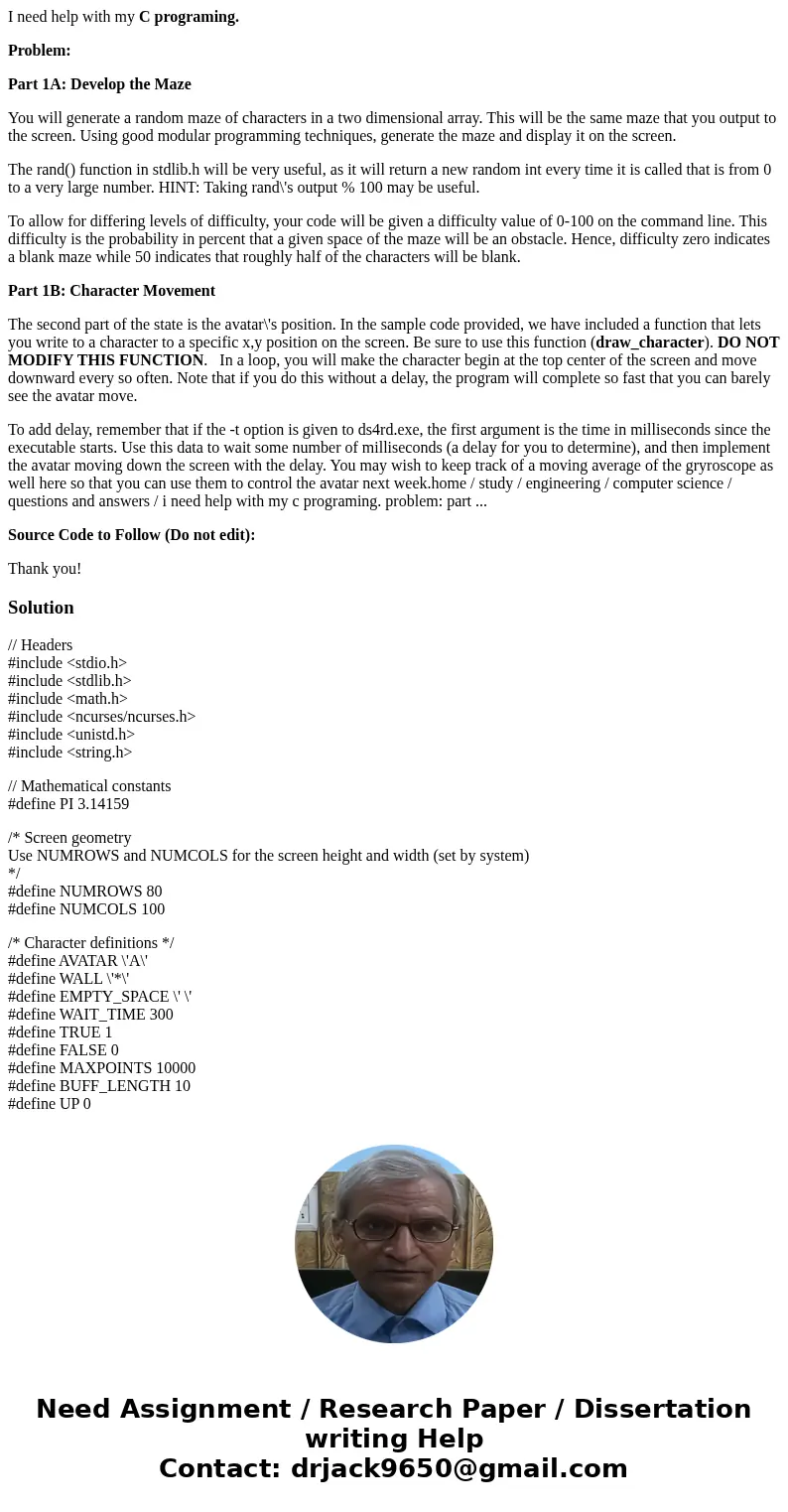
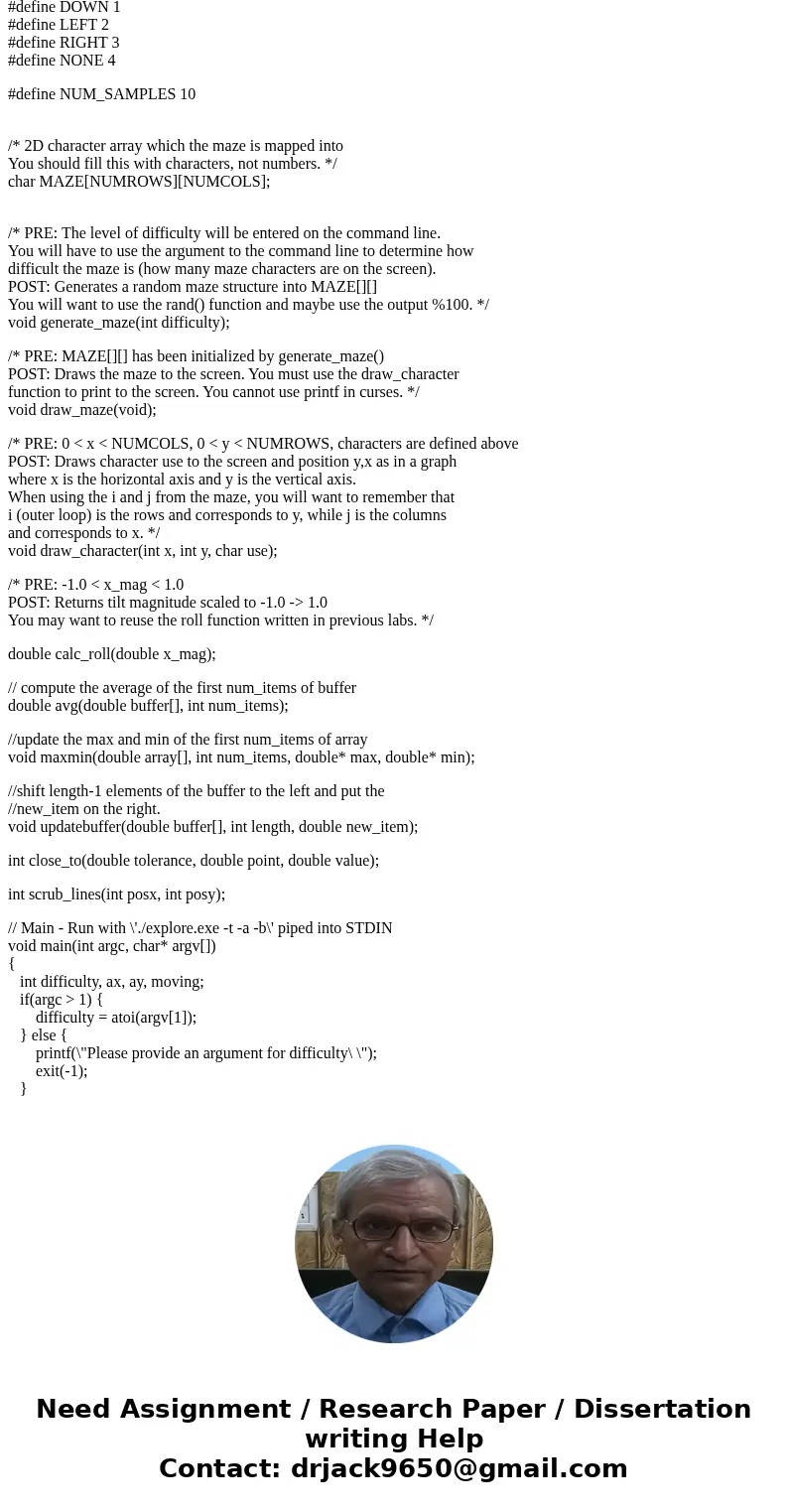
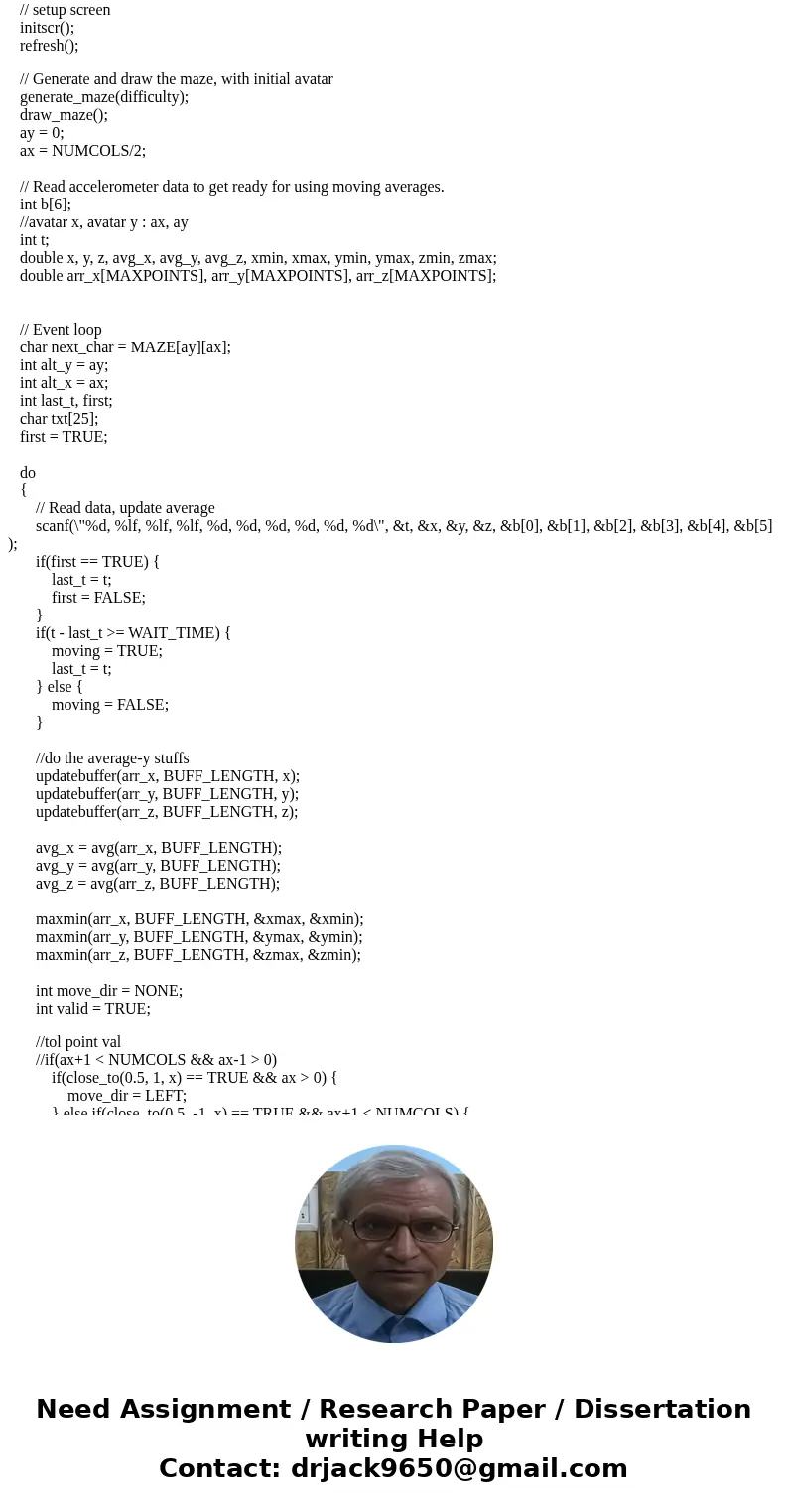
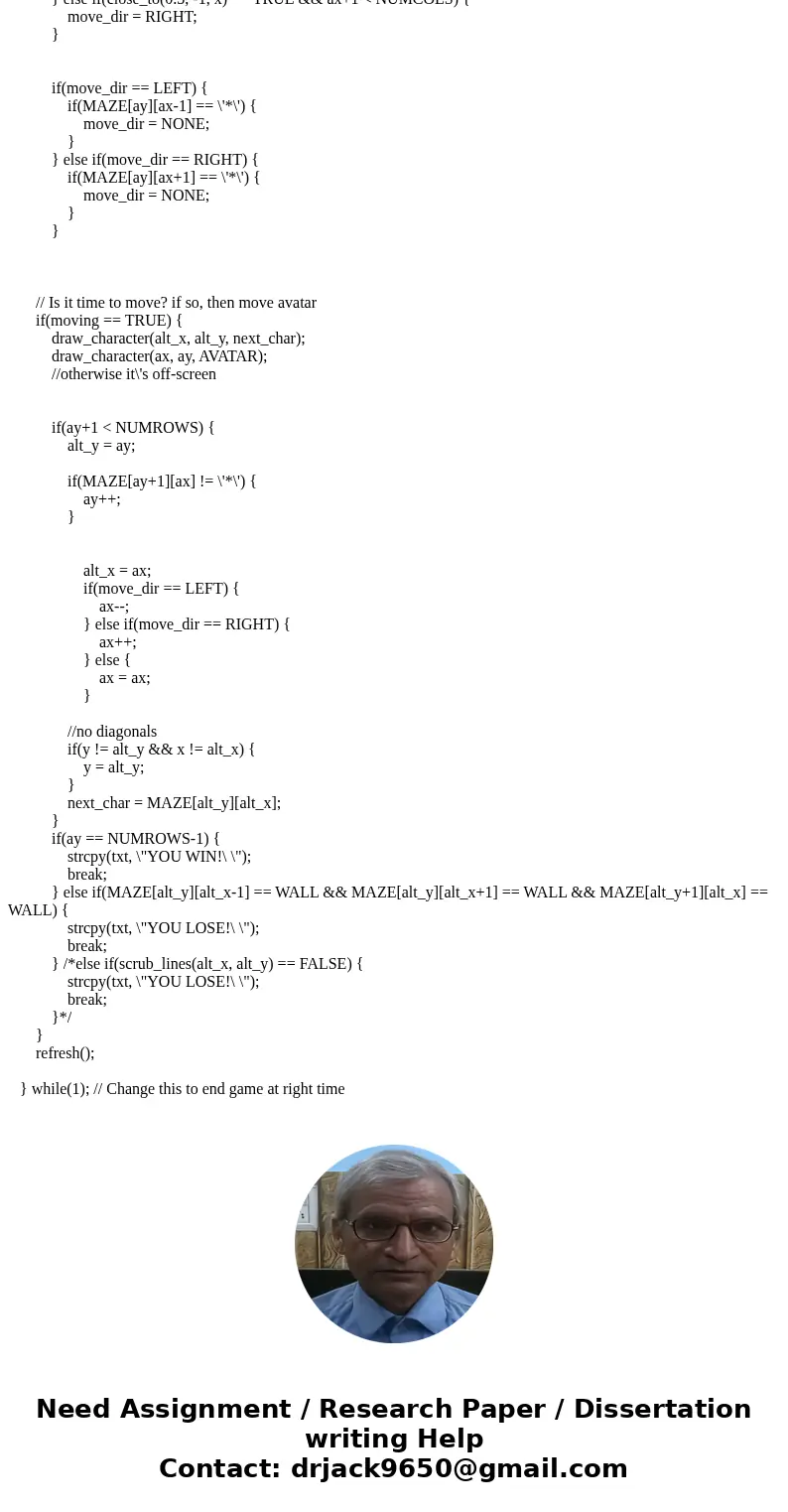
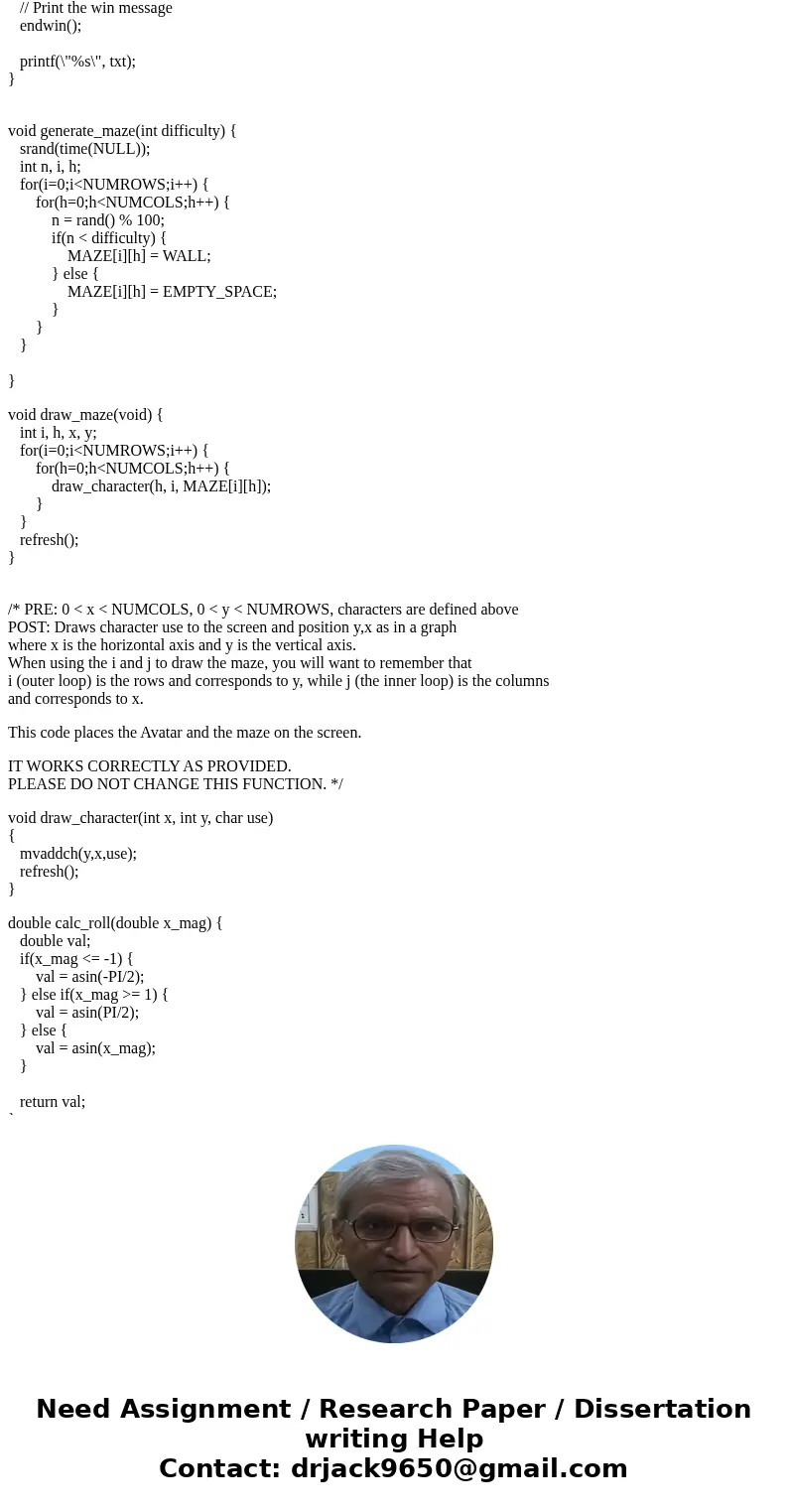
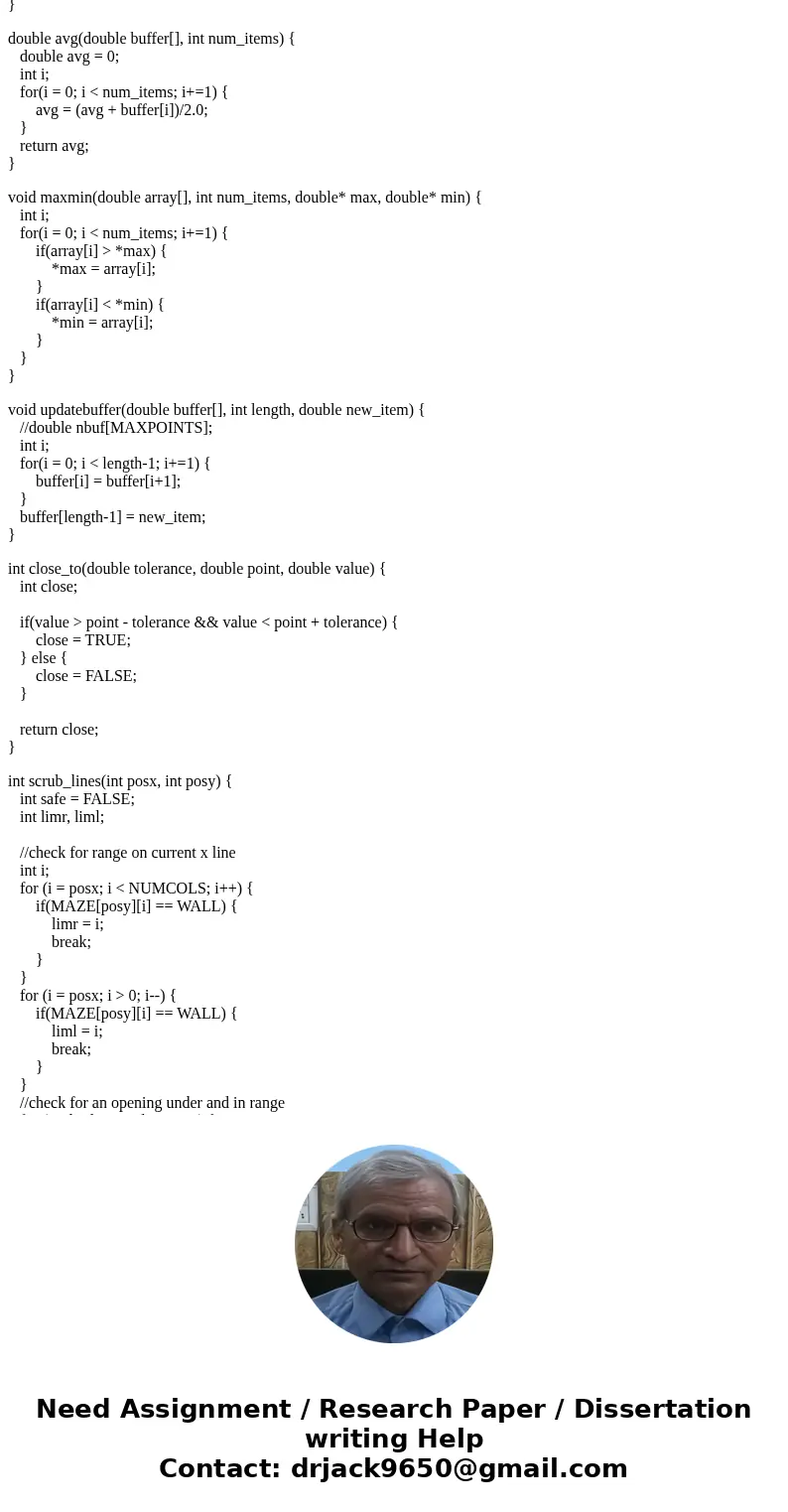
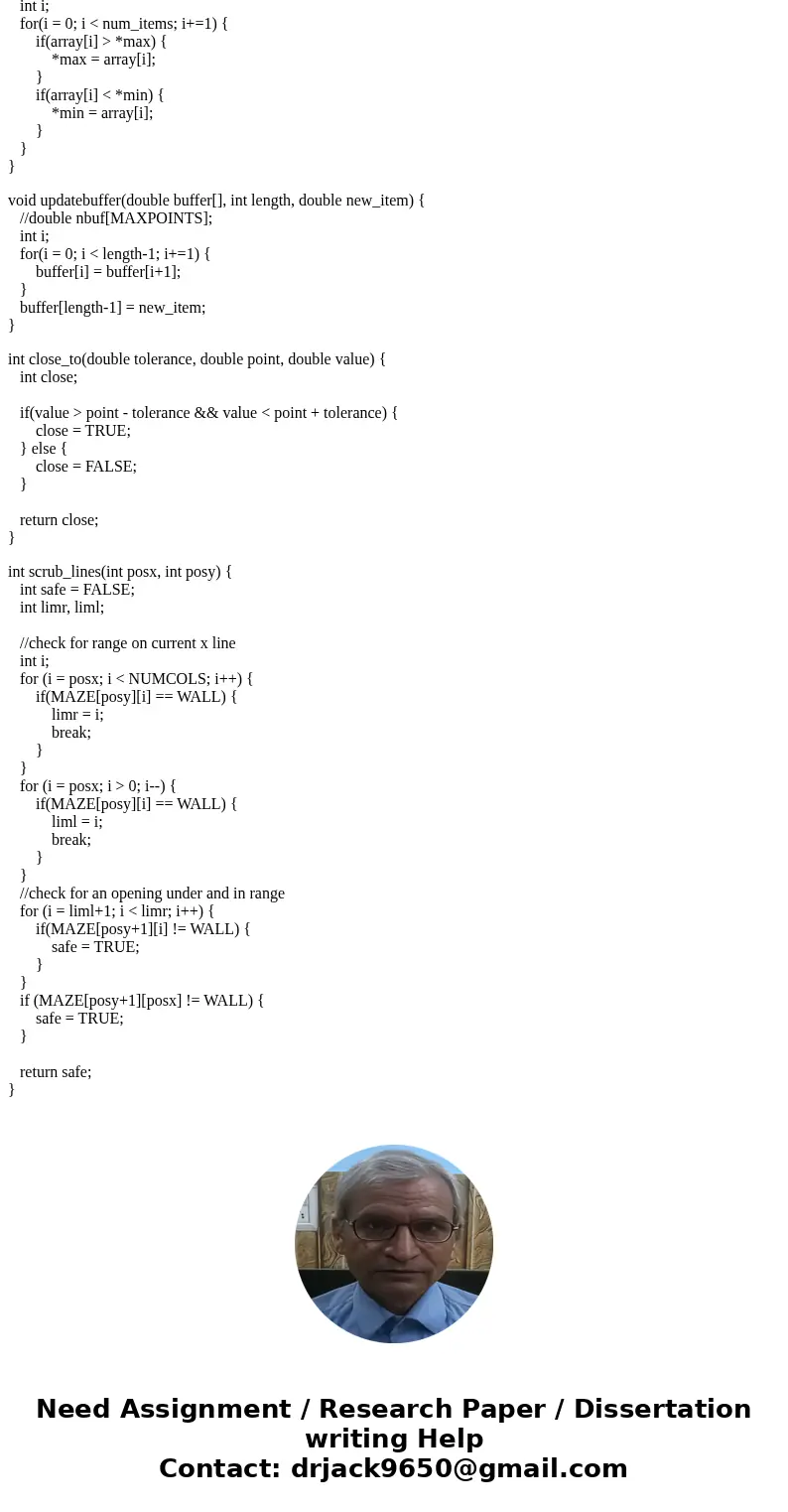
 Homework Sourse
Homework Sourse